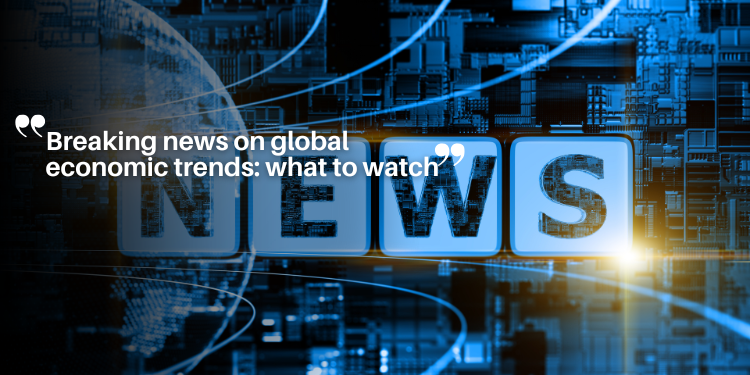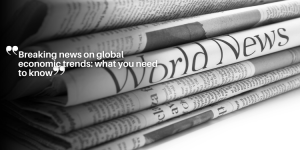Breaking news on global economic trends: what to watch

Predictions for the next quarter in economic growth are based on key indicators like consumer spending, industry trends, and external influences, providing insights into emerging and established markets.
Breaking news on global economic trends is essential for anyone looking to stay ahead in today’s fast-paced financial environment. Have you noticed how quickly things change? Let’s explore what these shifts mean for you.
Current shifts in global markets
The current shifts in global markets are reshaping how businesses operate and investors think. Understanding these changes is crucial for anyone involved in finance or investment. As economies worldwide adapt, new opportunities and challenges arise.
Economic Indicators to Watch
Monitoring certain economic indicators can provide valuable insight into market shifts. Here are a few key indicators:
- Gross Domestic Product (GDP) growth rates
- Unemployment rates
- Consumer confidence indexes
- Inflation rates
Each of these factors can influence market conditions. For example, a rise in consumer confidence usually signals that people are more willing to spend money, which can boost economic growth.
Geopolitical Events Impacting Markets
Geopolitical events can also lead to notable market shifts. Trade agreements, conflicts, and international policies play a significant role.
- Changes in trade tariffs can affect pricing
- Political instability can lead to market volatility
- Global summits influence economic strategies
For instance, recent trade negotiations between large economies have altered expectations for future growth. Such developments can create shifts that impact numerous sectors.
Investors must stay informed about these geopolitical dynamics to make well-rounded decisions. By keeping an eye on global trends, one can better anticipate potential market movements.
The power of technology in analyzing these shifts should not be overlooked. Many financial institutions use advanced algorithms to assess trends and patterns, making early predictions possible.
In summary, staying aware of the current shifts in global markets empowers investors and businesses alike to navigate the complex landscape of the economy effectively.
Impact of inflation on economies
Understanding the impact of inflation on economies is essential, especially in today’s world where prices seem to rise constantly. Inflation affects not just the prices of goods, but also how much money people have to spend and invest.
Effects on Purchasing Power
As inflation increases, the purchasing power of money decreases. This means you can buy fewer items with the same amount of money over time. For many families, this can lead to tough choices.
- Essentials become more expensive
- Discretionary spending often drops
- Saving money becomes challenging
For example, if prices rise by 3%, a family will need to earn more to maintain their standard of living. This change can lead to adjustments in budgeting and lifestyle.
Influence on Business Operations
Inflation also affects businesses. Companies may face rising costs for materials and labor, which can lead to higher prices for consumers.
- Businesses might reduce workforce
- Increase in product prices
- Investment plans may change
Companies that cannot keep up with rising costs might struggle to stay competitive in the market. This situation can lead to layoffs, which further impacts the economy.
Individuals and businesses alike need to adapt to a changing economic environment influenced by inflation. For instance, higher inflation rates often lead central banks to increase interest rates to stabilize the economy. These higher rates can affect borrowing costs for consumers and businesses, creating a ripple effect throughout the economy.
When considering investments, understanding the impact of inflation is crucial. Investors must think about how inflation might eat into their returns. For conservative investors, inflation can be a major concern, as it diminishes the real value of investments over time.
In summary, inflation has extensive effects on various aspects of the economy, from individual purchasing power to business operations and investment strategies.

Key regions to monitor for economic growth
When considering key regions to monitor for economic growth, it’s essential to look at both emerging and established markets. Different areas can show varying growth rates due to many factors, including resources, governmental policies, and technological advancements.
Emerging Markets
Emerging markets often present exciting opportunities. These regions generally have younger populations and growing consumer bases. Some notable emerging markets include:
- India
- Vietnam
- Brazil
- Nigeria
Each of these countries shows potential, driven by urbanization and rising middle classes. For instance, India is experiencing rapid growth in sectors like information technology and pharmaceuticals, attracting global investments.
Established Markets
While emerging markets are gaining attention, established markets also deserve scrutiny. Countries like the United States, Germany, and Japan maintain strong economic foundations.
- Technological innovation in the U.S.
- Engineering and manufacturing prowess in Germany
- Consumer market stabilization in Japan
These countries often lead global trends and significantly influence international markets. For instance, the U.S. tech industry continues to innovate, impacting worldwide economic dynamics. Additionally, the stability of Germany’s economy plays a crucial role in the European Union’s overall health.
Finally, regional trade agreements and partnerships can greatly influence growth prospects. Staying informed about trade negotiations and agreements can provide insights into which regions may experience rapid growth due to easier access to markets.
In summary, closely monitoring both emerging and established markets can grant valuable insights into where economic growth is likely to occur. By focusing on key regions, investors and businesses can make informed decisions that capitalize on future trends.
Predictions for the next quarter
Making predictions for the next quarter is a crucial aspect of economic planning. Analysts leverage trends, data, and economic indicators to forecast what lies ahead. These predictions can impact investment choices and business strategies significantly.
Economic Indicators to Consider
Several key indicators serve as a foundation for accurate predictions. It’s vital to pay attention to:
- Consumer spending trends
- Interest rates changes
- Employment statistics
- Market volatility
For instance, rising consumer spending often indicates confidence in the economy, suggesting that businesses might see growth in sales. Monitoring these indicators helps in understanding the overall health of the economy.
Industry-Specific Trends
Looking at specific industries can yield different insights. Sectors like technology, healthcare, and energy may behave differently in the upcoming quarter. Changes in consumer preferences can also significantly impact these areas.
- Tech industry growth driven by innovation
- Health sector adjustments due to regulatory changes
- Energy prices influenced by global supply
For example, the technological sector might experience a boost as companies invest in cutting-edge solutions. Conversely, regulatory changes in healthcare could reshape dynamics in that market.
Additionally, external factors such as geopolitical tensions and trade relations can also influence predictions. These elements often affect supply chains and financial markets, making them essential for accurate forecasting.
In the lead-up to the next quarter, many experts will analyze both domestic economic trends and international developments. By integrating various data points, analysts can provide more reliable predictions.
Understanding these factors and ongoing trends is essential for anyone looking to navigate the future landscape of the economy, especially as we approach critical decision-making periods.
In conclusion, predicting economic trends for the next quarter requires careful analysis of various factors. By monitoring key indicators like consumer spending and industry-specific trends, businesses and investors can make informed decisions. Understanding the dynamics of both emerging and established markets is essential. Additionally, being aware of external influences helps create reliable forecasts. As we look ahead, staying informed and adaptable will be crucial for navigating the upcoming economic landscape.
FAQ – Predictions for Economic Growth
What are the key indicators for predicting economic growth?
Key indicators include consumer spending, inflation rates, employment statistics, and market volatility.
Which regions should be monitored for economic growth?
Both emerging markets like India and established economies such as the U.S. and Germany should be closely watched.
How do industry-specific trends affect economic predictions?
Different sectors may face unique growth opportunities and challenges depending on consumer preferences and external factors.
What role do external influences play in economic forecasts?
Geopolitical events and trade relations can significantly impact market conditions and should be considered in any economic prediction.







